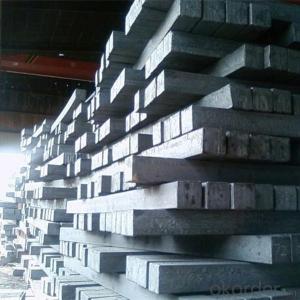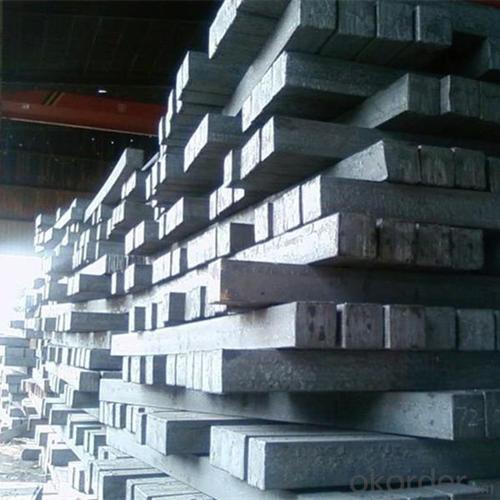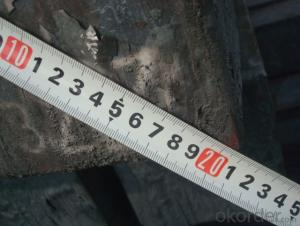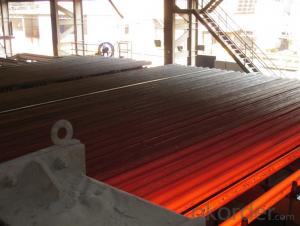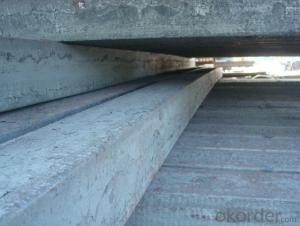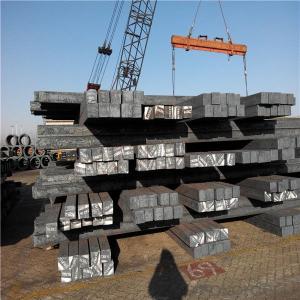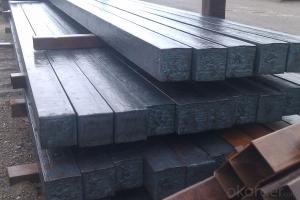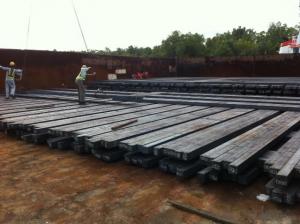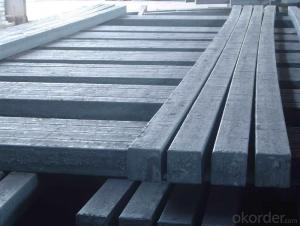2015 hot sale in China Q235 high quality Prime Steel billet
- Loading Port:
- China main port
- Payment Terms:
- TT OR LC
- Min Order Qty:
- 25 m.t.
- Supply Capability:
- 800000 m.t./month
OKorder Service Pledge
OKorder Financial Service
You Might Also Like
Quick Details
| Place of Origin: | Hebei, China (Mainland) | Brand Name: | CNBM | Model Number: | steel billets |
| Grade: | Q235,Q195,20MnSi etc. | Chemical Composition: | 2015 hot sale in China Q235,Q195, 20MnSi high quality Prime Steel bil | Shape: | Square, Square |
| Length: | 3-12m or as your request | Standard: | AISI, ASTM, BS, DIN, GB, JIS | Technique: | Hot Rolled |
| Dimensions: | 120-150 | Alloy Or Not: | Is Alloy | Secondary Or Not: | Non-secondary |
| Type: | prime quality steel billet | Quality: | Prime high quality | Application: | Wire rod , rod , deformed bars , profile steel etc. |
| Dimension: | 50mm-180mm or as your request | Price: | Competitive | Service: | Professional and good |
| Price terms: | CFR, CIF, FOB | Terms of payment: | L/C at sight or T/T | Delivery: | on time |
Packaging & Delivery
| Packaging Details: | standard packing for export |
| Delivery Detail: | within 25-45 days after receiving deposits or original LC |
2015 Hot Sale in China Q235 high quality Prime Steel billet , mild steel billet

Specifications
1.Grade: Q195, Q235, 20MnSi etc.
2.Terms of payment: TT or L/C at sight etc.
3.Size: 120-150 or as your request
- Q: What are the different types of surface defect detection equipment for steel billets?
- Steel billets have a variety of surface defect detection equipment available. These equipment are specifically designed to identify and analyze defects on the surface of steel billets, ensuring that only top-notch products are used for different applications. Some of the diverse types of surface defect detection equipment for steel billets include: 1. Ultrasonic Testing (UT): UT equipment utilizes sound waves to detect surface defects in steel billets. It emits high-frequency sound waves that penetrate the material and bounce back when they come across any surface irregularities. This method aids in the identification of cracks, voids, and other defects on the surface. 2. Eddy Current Testing (ECT): ECT equipment uses electromagnetic induction to detect surface defects in steel billets. It operates by passing an alternating current through a coil, generating a magnetic field that interacts with the conductive material of the billet. Any surface defect or irregularity causes a change in the magnetic field, which can be measured and analyzed. 3. Magnetic Particle Inspection (MPI): MPI equipment utilizes magnetic fields and iron particles to detect surface defects in steel billets. The billet is magnetized, and iron particles are applied to its surface. These particles gather around any surface defect, creating visible indications that can be easily identified and evaluated. 4. Visual Inspection: Visual inspection equipment involves the use of cameras, lasers, and other optical devices to detect surface defects in steel billets. These devices capture images or videos of the billet's surface, enabling inspectors to visually identify any irregularities or defects. 5. Thermographic Testing: Thermographic equipment uses infrared cameras to detect surface defects in steel billets by measuring temperature variations. Any defect causes a difference in heat transfer, resulting in distinct thermal patterns that can be detected and analyzed. 6. X-ray Inspection: X-ray inspection equipment employs X-ray radiation to penetrate the steel billet and detect internal and surface defects. It provides detailed images that allow inspectors to identify cracks, voids, and other defects that are not visible to the naked eye. In summary, these various types of surface defect detection equipment for steel billets offer a range of methods to ensure the quality and integrity of the billets, enabling manufacturers to deliver high-quality steel products to different industries.
- Q: What are the main factors affecting the corrosion resistance of stainless steel billets?
- The main factors affecting the corrosion resistance of stainless steel billets are the composition of the alloy, the presence of impurities, the manufacturing process, and the environment in which the billets are exposed. The composition of the stainless steel alloy plays a crucial role in determining its corrosion resistance. The addition of elements such as chromium, nickel, and molybdenum enhances the resistance to corrosion. These alloying elements form a protective oxide layer on the surface of the stainless steel, which acts as a barrier against corrosive agents. Impurities present in the stainless steel billets can also affect their corrosion resistance. For example, the presence of sulfur can lead to the formation of sulfide inclusions, which can decrease the overall corrosion resistance of the material. Therefore, the control of impurities during the manufacturing process is essential to ensure optimal corrosion resistance. The manufacturing process used to produce stainless steel billets can also impact their corrosion resistance. Factors such as temperature, cooling rate, and the presence of contaminants during the production process can affect the microstructure of the material, which in turn influences its corrosion resistance. Lastly, the environment in which the stainless steel billets are exposed plays a significant role in their corrosion resistance. Factors such as temperature, humidity, pH level, and the presence of corrosive agents such as acids or chlorides can accelerate the corrosion process. Therefore, it is essential to consider the specific environmental conditions when selecting stainless steel billets for a particular application. In conclusion, the corrosion resistance of stainless steel billets is influenced by the alloy composition, the presence of impurities, the manufacturing process, and the environment in which they are exposed. By carefully considering these factors, it is possible to select stainless steel billets with optimal corrosion resistance for a wide range of applications.
- Q: How are steel billets stored and transported?
- Steel billets, which are used for further processing, are carefully stored and transported to maintain their quality and safety. In terms of storage, steel billets are kept in designated areas within steel plants or warehouses, equipped with proper ventilation, drainage, and protection from the elements. They are organized in stacks with enough space between them for easy accessibility and inspection. To maximize space, steel billets are often stored vertically in racks or on specially designed shelves. This allows for easy handling and transportation. When it comes to transportation, heavy-duty equipment such as cranes or forklifts are used to move the billets safely, minimizing the risk of damage or injury. Chains or straps are used to secure the billets and prevent movement during transit. For longer distance transportation, steel billets are loaded onto trucks, trains, or ships. Containers or trailers are chosen based on the size and weight of the billets to ensure stability and safety. Proper weight distribution is crucial to maintain balance and prevent accidents. During transportation, it is important to protect the billets from moisture, extreme temperatures, and other external factors that could affect their quality. This may involve covering them with tarpaulins or using specialized containers. In conclusion, steel billets are stored and transported with great care to maintain their integrity and quality. Proper storage methods and suitable environmental conditions prevent damage and deterioration. Heavy-duty equipment and secure transportation minimize the risk of accidents. By following these practices, steel billets can be safely stored and transported, ready for further processing in the steel industry.
- Q: What is the difference between hot-rolled and cold-rolled steel billets?
- Hot-rolled steel billets and cold-rolled steel billets are two types of steel that undergo different manufacturing processes, resulting in distinct characteristics and properties. When producing hot-rolled steel billets, the steel is heated to a high temperature and then rolled while still hot. This process allows for easy shaping and forming into various sizes and shapes. Additionally, hot-rolling creates a rough surface finish and a scaled outer layer due to exposure to high temperatures. Generally, hot-rolled steel billets have a larger grain structure, which can result in a less precise and uniform final product. However, they also possess improved mechanical properties, such as higher strength and toughness, making them suitable for applications where strength is important, but surface finish is not a priority. In contrast, cold-rolled steel billets are produced by cooling the steel to a low temperature and rolling it at room temperature. This process allows for tighter dimensional tolerances and a smoother surface finish compared to hot-rolled steel billets. Additionally, cold-rolling results in a more refined grain structure, which enhances the overall strength, hardness, and durability of the steel. Cold-rolled steel billets are commonly used in applications where precise dimensions, surface finish, and uniformity are required, such as in the automotive, construction, and appliance industries. To summarize, the main difference between hot-rolled and cold-rolled steel billets lies in the manufacturing processes and resulting properties. Hot-rolled steel billets are formed at high temperatures, resulting in a rough surface finish and larger grain structure. Cold-rolled steel billets, on the other hand, are formed at room temperature, leading to tighter dimensional tolerances, a smoother surface finish, and a more refined grain structure. The choice between hot-rolled and cold-rolled steel billets depends on specific requirements and applications, with hot-rolled steel billets being preferred for their superior strength and cold-rolled steel billets for their precise dimensions and surface finish.
- Q: What are the different types of steel billet packaging?
- There are several types of steel billet packaging, including wooden crates, steel or plastic wrapping, and steel wire or strapping.
- Q: What are the different types of straightening methods used for steel billets?
- There are several different types of straightening methods used for steel billets, depending on the specific requirements and desired outcome. These methods include: 1. Roller Straightening: This method involves passing the steel billets through a series of rollers that apply pressure in various directions to straighten them. The rollers can be adjusted to apply more pressure on certain areas of the billet that may be bent or twisted. 2. Hydraulic Straightening: In this method, hydraulic presses are used to apply pressure on the billets, either in a single direction or in multiple directions. The pressure can be adjusted to achieve the desired level of straightness. 3. Heat Straightening: Heat straightening is a method that involves applying heat to the bent or twisted areas of the steel billets and then using hydraulic or mechanical tools to straighten them. The heat softens the steel, allowing it to be reshaped more easily. 4. Hammering: Hammering is a traditional method of straightening steel billets, where skilled workers use hammers and anvils to manually reshape the billets. This method requires a high level of skill and precision to achieve the desired straightness. 5. Magnetic Straightening: Magnetic straightening is a non-contact method that uses magnetic fields to apply forces on the steel billets and straighten them. This method is often used for smaller and thinner billets, where other methods may cause damage or distortion. Each of these straightening methods has its own advantages and limitations, and the choice of method depends on factors such as the size and thickness of the billets, the degree of straightness required, and the available equipment and resources.
- Q: How are steel billets used in the production of structural components?
- Steel billets are used in the production of structural components by being heated and molded into desired shapes such as beams, columns, and plates. These billets serve as the starting material, which is then further processed through rolling, forging, or extrusion to create strong and durable structural components used in various industries such as construction, automotive, and aerospace.
- Q: How are steel billets used in the production of industrial pumps?
- Industrial pumps rely on steel billets as a vital ingredient in their manufacturing process. These billets serve as the primary material from which the different pump parts are created. To commence, the steel billets are initially heated to a specific temperature to render them pliable and more manageable. Following this, they are placed within a forging machine where they endure substantial pressure and are shaped into the desired form. This procedure, known as forging, allows the billets to be converted into diverse pump components, including impellers, casings, and shafts. Once the components have been forged, they undergo a sequence of machining operations to further refine their shape and dimensions. This encompasses milling, drilling, and grinding in order to achieve the necessary tolerances and surface finish. These operations are critical to ensure the correct fit and functionality of the pump parts. The steel billets employed in the production of industrial pumps are typically crafted from high-quality steel alloys that possess exceptional strength, durability, and resistance to corrosion and wear. This guarantees that the resulting pump components can endure the demanding operating conditions frequently encountered in industrial applications. Moreover, the use of steel billets enables the customization of pump parts to meet specific requirements. By altering the shape and dimensions of the billets, manufacturers can achieve different pump designs and sizes. This production flexibility allows manufacturers to cater to a broad array of pump applications across diverse industries. In conclusion, steel billets occupy a pivotal role in the production of industrial pumps. Through the process of forging, machining, and customization, these billets are transformed into top-notch pump components that offer superior performance and reliability in industrial environments.
- Q: What are the different surface finishing techniques used for steel billets?
- There are several surface finishing techniques that are commonly used for steel billets. These techniques are employed to enhance the appearance, improve corrosion resistance, and provide a protective coating to the steel billets. Some of the different surface finishing techniques used for steel billets are: 1. Hot Rolling: This technique involves passing the steel billets through a series of hot rollers, which not only shapes the billets but also creates a smooth surface finish. Hot rolling is commonly used to produce steel plates, sheets, or structural shapes. 2. Cold Rolling: Cold rolling is similar to hot rolling, but it is performed at room temperature. This technique helps to achieve a smoother surface finish, increased dimensional accuracy, and improved mechanical properties of the steel billets. 3. Shot Blasting: Shot blasting is a process where steel billets are bombarded with small metallic or non-metallic particles at high velocity. This technique helps to remove scale, rust, and other contaminants from the billet's surface, resulting in a clean and uniform appearance. 4. Pickling: Pickling involves immersing the steel billets in an acid solution to remove oxides, scale, and rust from the surface. This technique helps to achieve a clean and smooth surface finish, ready for further processing or coating. 5. Galvanizing: Galvanizing is a popular surface finishing technique that involves coating the steel billets with a layer of zinc. This coating provides excellent corrosion resistance and protects the steel from environmental factors. Galvanizing can be done through hot-dip galvanizing, electro-galvanizing, or mechanical galvanizing methods. 6. Painting: Painting is often used as a surface finishing technique for steel billets. It involves applying a layer of paint or protective coating to the surface, which not only enhances the appearance but also provides protection against corrosion and weathering. 7. Passivation: Passivation is a chemical process used to remove free iron or iron oxides from the surface of steel billets. This process helps to improve the corrosion resistance of the steel and leaves a clean and passive surface. 8. Polishing: Polishing involves using abrasive materials or compounds to smoothen the surface of the steel billets. This technique is commonly used to achieve a high gloss or mirror-like finish, enhancing the aesthetic appeal of the steel. Each of these surface finishing techniques offers its own advantages and is chosen based on the specific requirements of the steel billets, such as appearance, corrosion resistance, and functionality.
- Q: How are steel billets inspected for dimensional accuracy?
- To guarantee that steel billets meet the required specifications, a series of rigorous processes are undertaken to inspect their dimensional accuracy. These inspections play a crucial role, as any discrepancies in dimensions can significantly impact the quality and performance of the final product. The initial step involves a visual inspection of the steel billets, carried out by trained personnel with a keen eye for detail. This inspection aims to identify any surface defects or irregularities that could affect the dimensions, including cracks, surface oxidation, or any other visible abnormalities. Following the visual inspection, the billets undergo dimensional measurement using various tools and instruments. A commonly used tool is the caliper, which measures the length, width, and height of the billet. These measurements are then compared against the specified dimensions to ensure they fall within an acceptable range. Any deviations beyond the tolerance limit are flagged for further investigation. In addition to calipers, other tools such as micrometers, height gauges, and coordinate measuring machines (CMM) may be utilized to measure specific dimensions or features of the billet. These instruments provide more precise and accurate measurements, particularly for critical dimensions that require a higher level of precision. Furthermore, non-destructive testing techniques are employed to assess the internal quality and dimensional accuracy of the billets. Ultrasonic testing, for example, employs high-frequency sound waves to detect any internal defects or inconsistencies that may affect the dimensions. This method is capable of identifying hidden flaws like voids, inclusions, or discontinuities, providing a comprehensive evaluation of the billet's dimensional accuracy. In summary, manufacturers ensure the dimensional accuracy of steel billets through a combination of visual inspections, dimensional measurements using various tools, and non-destructive testing techniques. By conducting these inspections, they can ensure that the billets meet the required specifications, leading to the production of high-quality final products.
Send your message to us
2015 hot sale in China Q235 high quality Prime Steel billet
- Loading Port:
- China main port
- Payment Terms:
- TT OR LC
- Min Order Qty:
- 25 m.t.
- Supply Capability:
- 800000 m.t./month
OKorder Service Pledge
OKorder Financial Service
Similar products
Hot products
Hot Searches
Related keywords
